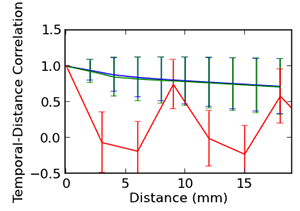Overview

To minimize slice excitation leakage to adjacent slices, interleaved slice acquisition is nowadays performed regularly in fMRI scanners. In interleaved slice acquisition, the number of slices skipped between two consecutive slice acquisitions is often referred to as the ‘interleave parameter’; the loss of this parameter can be catastrophic for the analysis of fMRI data. In this project we present a method to retrospectively detect the interleave parameter and the axis in which it is applied. Our method relies on the smoothness of the temporal-distance correlation function, which becomes disrupted along the axis on which interleaved slice acquisition is applied. Figure to the right show the disruption of the temporal-distance correlation function along the Z axis while it remain smooth for the other two axis. We examined this method on simulated and real data in the presence of fMRI artifacts such as physiological noise, motion, etc. Figure below illustrates the cross-correlogram of the temporal-distance correlation function for three fMRI scans with different interleaved parameters; first, is for sequential acquisition (no interleave), Second , is the even-odd interleave, and the third one is the Philips interleave (skip six slices).

In addition we developed an statistical method to extract the interleaved parameter from the cross-correlogram which gives a probability of confidence for the extracted parameter. We also examined the reliability of this method in detecting different types of interleave parameters and demonstrated an accuracy of about 94% in more than 1000 real fMRI scans. The code for this technique is developed in Matlab and can be download from the link below along with the required instruction on how to execute the code.
Related Publication
D. Parker, G.Rotival, A. Laine, and Q. R. Razlighi, “Retrospective Detection of Interleaved Slice Acquisition Parameters From fMRI Data,” IEEE international Symposium on Biomedical Imaging, Beijing, China, 2014, Download Paper
Software Released
Matlab Code and Instruction can be downloaded from the following link

